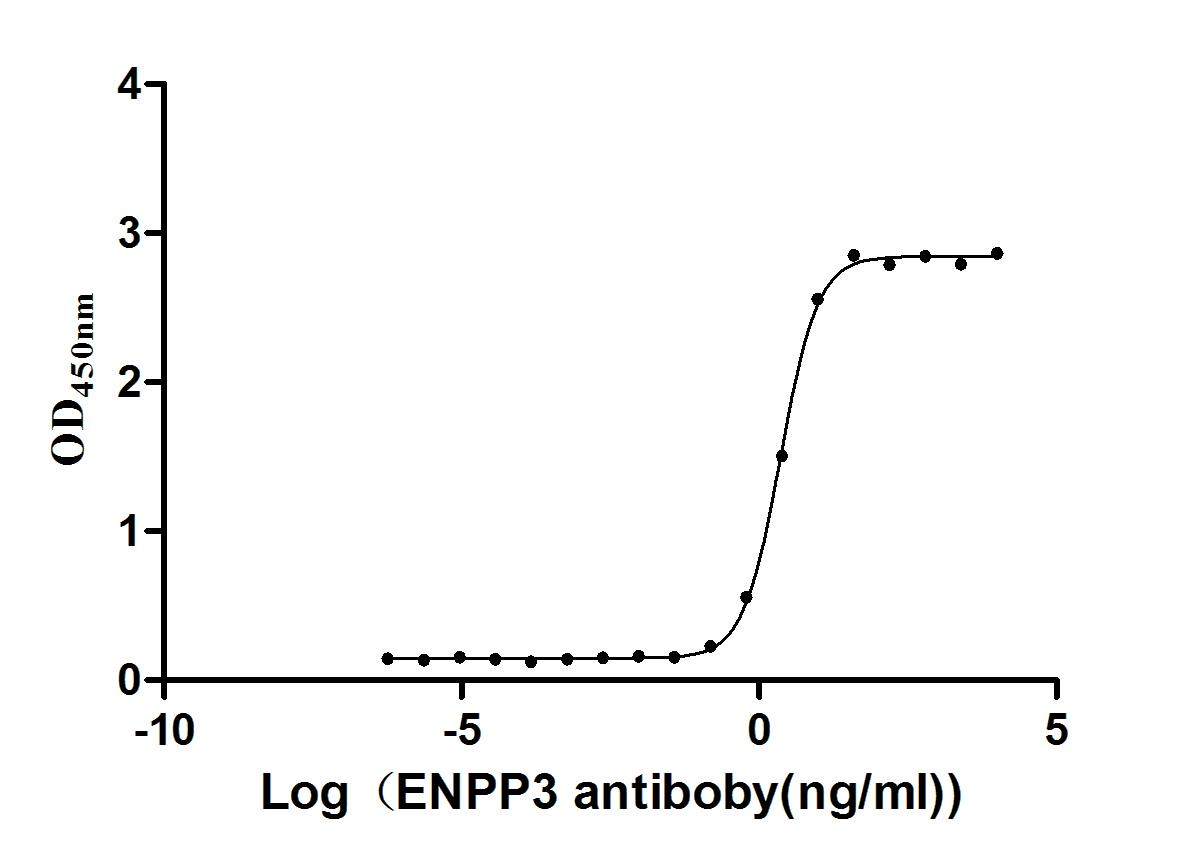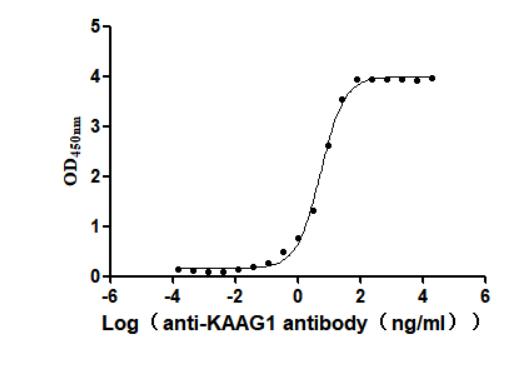Recombinant Saccharomyces cerevisiae Ubiquitin-conjugating enzyme E2-34 kDa (CDC34)
-
中文名稱:Recombinant Saccharomyces cerevisiae Ubiquitin-conjugating enzyme E2-34 kDa(CDC34),Yeast
-
貨號(hào):CSB-YP321282SVG
-
規(guī)格:
-
來源:Yeast
-
其他:
-
中文名稱:Recombinant Saccharomyces cerevisiae Ubiquitin-conjugating enzyme E2-34 kDa(CDC34),Yeast
-
貨號(hào):CSB-EP321282SVG
-
規(guī)格:
-
來源:E.coli
-
其他:
-
中文名稱:Recombinant Saccharomyces cerevisiae Ubiquitin-conjugating enzyme E2-34 kDa(CDC34),Yeast
-
貨號(hào):CSB-EP321282SVG-B
-
規(guī)格:
-
來源:E.coli
-
共軛:Avi-tag Biotinylated
E. coli biotin ligase (BirA) is highly specific in covalently attaching biotin to the 15 amino acid AviTag peptide. This recombinant protein was biotinylated in vivo by AviTag-BirA technology, which method is BriA catalyzes amide linkage between the biotin and the specific lysine of the AviTag.
-
其他:
-
中文名稱:Recombinant Saccharomyces cerevisiae Ubiquitin-conjugating enzyme E2-34 kDa(CDC34),Yeast
-
貨號(hào):CSB-BP321282SVG
-
規(guī)格:
-
來源:Baculovirus
-
其他:
-
中文名稱:Recombinant Saccharomyces cerevisiae Ubiquitin-conjugating enzyme E2-34 kDa(CDC34),Yeast
-
貨號(hào):CSB-MP321282SVG
-
規(guī)格:
-
來源:Mammalian cell
-
其他:
產(chǎn)品詳情
-
純度:>85% (SDS-PAGE)
-
基因名:
-
Uniprot No.:
-
別名:CDC34; DNA6; UBC3; YDR054C; D4211; YD9609.08C; Ubiquitin-conjugating enzyme E2-34 kDa; EC 2.3.2.23; Cell division control protein 34; E2 ubiquitin-conjugating enzyme 3; E3 ubiquitin ligase complex SCF subunit CDC34; Ubiquitin carrier protein; Ubiquitin-protein ligase
-
種屬:Saccharomyces cerevisiae (strain ATCC 204508 / S288c) (Baker's yeast)
-
蛋白長(zhǎng)度:full length protein
-
表達(dá)區(qū)域:1-295
-
氨基酸序列MSSRKSTASS LLLRQYRELT DPKKAIPSFH IELEDDSNIF TWNIGVMVLN EDSIYHGGFF KAQMRFPEDF PFSPPQFRFT PAIYHPNVYR DGRLCISILH QSGDPMTDEP DAETWSPVQT VESVLISIVS LLEDPNINSP ANVDAAVDYR KNPEQYKQRV KMEVERSKQD IPKGFIMPTS ESAYISQSKL DEPESNKDMA DNFWYDSDLD DDENGSVILQ DDDYDDGNNH IPFEDDDVYN YNDNDDDDER IEFEDDDDDD DDSIDNDSVM DRKQPHKAED ESEDVEDVER VSKKI
-
蛋白標(biāo)簽:Tag?type?will?be?determined?during?the?manufacturing?process.
The tag type will be determined during production process. If you have specified tag type, please tell us and we will develop the specified tag preferentially. -
產(chǎn)品提供形式:Lyophilized powder
Note: We will preferentially ship the format that we have in stock, however, if you have any special requirement for the format, please remark your requirement when placing the order, we will prepare according to your demand. -
復(fù)溶:We recommend that this vial be briefly centrifuged prior to opening to bring the contents to the bottom. Please reconstitute protein in deionized sterile water to a concentration of 0.1-1.0 mg/mL.We recommend to add 5-50% of glycerol (final concentration) and aliquot for long-term storage at -20℃/-80℃. Our default final concentration of glycerol is 50%. Customers could use it as reference.
-
儲(chǔ)存條件:Store at -20°C/-80°C upon receipt, aliquoting is necessary for mutiple use. Avoid repeated freeze-thaw cycles.
-
保質(zhì)期:The shelf life is related to many factors, storage state, buffer ingredients, storage temperature and the stability of the protein itself.
Generally, the shelf life of liquid form is 6 months at -20°C/-80°C. The shelf life of lyophilized form is 12 months at -20°C/-80°C. -
貨期:Delivery time may differ from different purchasing way or location, please kindly consult your local distributors for specific delivery time.Note: All of our proteins are default shipped with normal blue ice packs, if you request to ship with dry ice, please communicate with us in advance and extra fees will be charged.
-
注意事項(xiàng):Repeated freezing and thawing is not recommended. Store working aliquots at 4°C for up to one week.
-
Datasheet :Please contact us to get it.
靶點(diǎn)詳情
-
功能:Catalyzes the covalent attachment of ubiquitin to other proteins. Capable, in vitro, to ubiquitinate histone H2A.; Mediates the initiation of DNA replication (transition of G1 to S phase in cell cycle). Essential component of the E3 ubiquitin ligase complex SCF (SKP1-CUL1-F-box protein), which mediates the ubiquitination and subsequent proteasomal degradation of target proteins. Involved in the regulation of methionine biosynthesis genes and in the degradation of CDC6 together with CDC4 and CDC53.
-
基因功能參考文獻(xiàn):
- Cdc34 phosphorylation by PKA and Sch9 provides a direct tether between G1 cell division events and cell growth PMID: 22087249
- Cdc34 showed a strong preference for Ub lysine 48 (K48), with lower activity towards lysine 11 (K11) and lysine 63 (K63). PMID: 23656784
- chromosome segregation in cdc6 mutant is caused by the deregulation of spindle dynamics induced via a regulatory network involving the ubiquitin-conjugating enzyme Cdc34, microtubule-associated proteins and the anaphase-promoting complex activator Cdh1. PMID: 22805765
- Cdc34 is particularly sensitive to oxidative inactivation, through sequestration of the catalytic cysteine in a disulfide complex with Uba1, by levels of oxidant that do not reduce global ubiquitinylation of proteins. PMID: 22949505
- Through analysis of the phenotype of a mutant missing a highly conserved sequence motif within the catalytic domain of Cdc34, we discovered previously unrecognized levels of regulation PMID: 21196523
- Data show that proximal amino acids surrounding the lysine residues in Sic1 and Ub are critical for ubiquitination, and that this mechanism is linked to key residues composing the catalytic core of Cdc34 and independent of SCF. PMID: 20194622
- The acidic loop of CDC34 favorably positions K48 of a substrate-linked ubiquitin to attack SCF bound Cdc34-ubiquitin thioester and thereby enables processive synthesis of K48-linked ubiquitin chains by SCF-Cdc34. PMID: 16360039
- We propose that interactions between Cdc34 approximately Ub and SCF directly activate ubiquitin transfer within a substrate-SCF-Cdc34 approximately Ub ternary complex. PMID: 17114057
- studies demonstrate that CK2-mediated phosphorylation of Cdc34 on the acidic tail domain stimulates Cdc34-SCFCdc4 ubiquitination activity and cell cycle progression PMID: 17461777
- In in vitro experiments with single-lysine-containing Cdc34 mutant proteins of Saccharomyces cerevisiae, the SCF-mediated stimulation of autoubiquitination is limited to specific N-terminal lysines modified via an intermolecular mechanism. PMID: 17562869
- The CK2 phosphorylation of catalytic domain of Cdc34 modulates its activity at the G1 to S transition in Saccharomyces cerevisiae. PMID: 18418079
- The acidic tail of the Cdc34 ubiquitin-conjugating enzyme functions in both binding to and catalysis with ubiquitin ligase SCFCdc4. PMID: 19875449
顯示更多
收起更多
-
亞細(xì)胞定位:Cytoplasm. Nucleus.
-
蛋白家族:Ubiquitin-conjugating enzyme family
-
數(shù)據(jù)庫鏈接:
KEGG: sce:YDR054C
STRING: 4932.YDR054C
Most popular with customers
-
Recombinant Human E3 ubiquitin-protein ligase ZNRF3 (ZNRF3), partial (Active)
Express system: Mammalian cell
Species: Homo sapiens (Human)
-
Recombinant Dog Angiopoietin-2 (ANGPT2) (Active)
Express system: Mammalian cell
Species: Canis lupus familiaris (Dog) (Canis familiaris)
-
Express system: Mammalian cell
Species: Homo sapiens (Human)
-
Recombinant Human Zymogen granule protein 16 homolog B (ZG16B) (Active)
Express system: Mammalian cell
Species: Homo sapiens (Human)
-
Recombinant Human Mucin-17 (MUC17), partial (Active)
Express system: Mammalian cell
Species: Homo sapiens (Human)
-
Recombinant Human Claudin-6 (CLDN6)-VLPs, Fluorescent (Active)
Express system: Mammalian cell
Species: Homo sapiens (Human)
-
Recombinant Human Cytotoxic and regulatory T-cell molecule (CRTAM), partial (Active)
Express system: Mammalian cell
Species: Homo sapiens (Human)
-
Recombinant Human Kidney-associated antigen 1(KAAG1) (Active)
Express system: Baculovirus
Species: Homo sapiens (Human)







f4-AC1.jpg)










